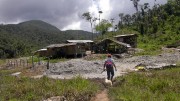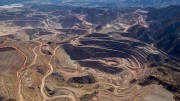The first time I met Harry Ferderber was in Cuba in the late 1970s. At the time, he was a well-known figure in the island country, and with his dark looks and thick black moustache, he resembled the Mexican general and revolutionary Francisco “Pancho” Villa. Many of the locals might have thought he was a fellow Latino, were it not for the fact that he stood a few inches above most of them. Nevertheless, he received a lot of glances from female admirers (and their jealous partners).
The working conditions in Cuba were always difficult. One spring in particular, heavy rains caused a weighty build-up of mud where we were working. Ferderber took it all in stride, along with the occupational problem of “bigfoot,” a swelling and numbness caused by excessive exposure to moisture, which plagued us all. The mud was sticky, and kept adding layers to the bottoms of our feet until each of us was a few inches taller. This wasn’t a problem until one of the gobs of mud fell off, leaving one to hobble along, bobbing up and down. Ferderber stood well above the brush and sage bushes, and you could often see his head bobbing up and down as he struggled in the mire.
Our next big geophysical project was in Zuni, N.M. There, line-cutting became a huge hassle with lots of small trees and bushes growing in the logged-over area. Our helpers used hatchets and small axes to slice through the brush, but not Ferderber. Someone gave him a big, heavy machete that he usually wore in a canvas scabbard at his right side. This only added to his Pancho Villa mystique as he swashbuckled his way through the bush. Perhaps this was even more evident when he would venture into the local watering hole with the giant blade still strapped to his side.
I look back at our times in Orogrande, N.M., when, as at Zuni, we had to fight our way through desert scrub and thorn bushes. Even more dangerous were the hidden abandoned mine shafts with small dumps hidden under the brush. Rattlesnakes were also common, but I would only see one or two a week while following in Ferderber’s footsteps. He would kill about three or four snakes a day! I never figured out if it was his eyes or ears that were better than mine, and he would never divulge his secret. His keen hunting skills kept one of the other geologists, Steve Lewandowski, plush with snake skins, which he would make into hat bands. Ferderber never wanted one, and his little helper swore he was scared to death of rattlesnakes, but he would kill them anyway.
Ferderber had one episode of the flu while he was stationed in Orogrande. The bartender at the Rocket Motel in El Paso swore that Tequila would cure him. He gave Ferderber the bottle, and he and his helper finished it that night. The following morning he showed up with bloodshot eyes and a fifty-pound hangover. He said it was just a bad case of the flu, but he never drank tequila again.
Then there was Hermosa, N.M. Joe Glines, who was involved in the project, decided Ferderber was his best buddy and wanted to show him everything in the district. The big geologist went along with Glines but drew the line after being dragged into a cave filled with bats.
Ferderber was also the only one who could hold his own against local poker ace Ron Redding. Redding could literally look in two directions at once. Everyone had trouble reading his expressions, but apparently Harry knew which eye to watch.
Sometime later, we were all driving back to camp for lunch when we saw Charlie Maxwell, of the U.S. Geological Survey, perched high in a tree. We stopped the truck and were about to exit when Maxwell shouted “get back in the truck!” Just as we did, about a dozen wild javalinas, also known as wild pigs, charged at us. They had “treed” Charlie about three hours earlier and he was getting weary in his perch. We had several rifles inside the truck and I passed one back to Ferderber, who was sitting in the truck bed. He was able to shoot four of the beasts before they ran off. Mean critters.
Ferderber was a regular guy, and all the crews liked him. At the drop of a hat, he was ready to help anyone who needed it, especially the “tenderfoots” in camp.
I had lots of long talks with Ferderber, mostly because he was always willing to tell us what was going on and what he was finding. Geophysicists often won’t talk much in the field, preferring instead to wait until the field report is written, but sometimes we needed immediate information, and Ferderber frequently came through with his best guess at the moment.
Sadly, Harry Ferderber passed away recently. This great worker, professional geoscientist and dear friend will be missed.
— The author is a consulting geologist based in Albuquerque, N.M.



Be the first to comment on "Odds ‘n’ sods: Remembering Harry Ferderber"